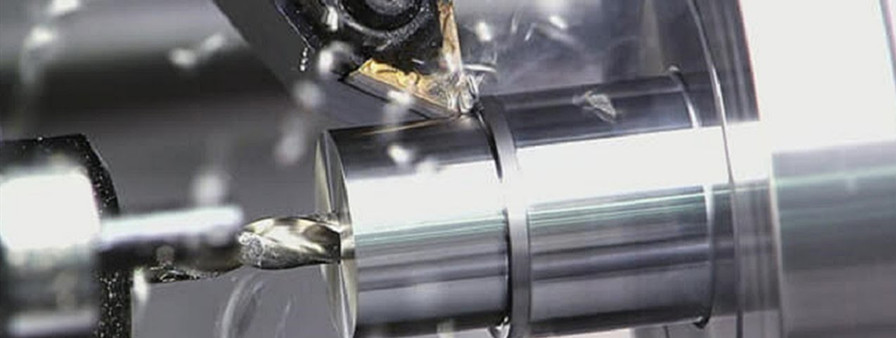In modern manufacturing, aluminum alloy 7075 is widely used in aerospace, automobile manufacturing, electronic products and other fields due to its excellent strength-to-weight ratio, good corrosion resistance and processing performance. CNC turning is a common and efficient processing method for processing aluminum alloy 7075. However, in order to achieve the ideal processing effect, it is essential to master some practical skills.
Choice of tools
The performance of the tool plays a decisive role in the turning quality and efficiency of aluminum alloy 7075. Due to the soft texture and high viscosity of aluminum alloy 7075, it is easy to produce built-up edge on the surface of the tool, affecting the processing accuracy and surface roughness. Therefore, it is key to choose a sharp and anti-adhesion tool.
Carbide tools are a common choice for turning aluminum alloy 7075. It has hardness, high wear resistance and good hot hardness, and can maintain the sharpness of the tool under high-speed cutting conditions. Especially for coated carbide tools, by coating one or more layers of special materials on the tool surface, such as TiN (titanium nitride), TiAlN (titanium aluminum nitride), etc., the tool’s anti-adhesion and wear resistance can be further improved, the cutting force can be reduced, and the generation of built-up edge can be reduced. For example, TiAlN coated tools have excellent oxidation resistance at high temperatures, can effectively extend tool life, and are suitable for high-speed and efficient turning.
For some processing tasks with extremely high surface quality requirements, such as turning of optical parts, PCD (polycrystalline diamond) tools are the best choice. PCD tools have extremely high hardness and wear resistance, extremely sharp edges, and can achieve ultra-precision processing and obtain extremely low surface roughness. However, PCD tools are more expensive and have more stringent requirements on the accuracy and stability of machine tools.
Optimization of cutting parameters
Reasonable cutting parameters are an important factor in ensuring processing quality and improving processing efficiency. When turning aluminum alloy 7075, the three main parameters involved are cutting speed, feed rate and cutting depth.
The choice of cutting speed directly affects processing efficiency and tool life. Generally speaking, the cutting speed of aluminum alloy 7075 can be adjusted according to the tool material and workpiece diameter. For carbide tools, the cutting speed is usually between 200-500m/min; when using PCD tools, the cutting speed can be as high as 1000m/min or more. However, it should be noted that too high a cutting speed will lead to increased tool wear and even excessive cutting heat, which will cause the workpiece to deform. Therefore, in actual processing, experiments should be carried out according to specific conditions to find the best cutting speed.
The feed rate determines the distance the tool moves along the axial direction of the workpiece per unit time. If the feed rate is too large, the roughness of the machined surface will increase and may even cause the tool to break; if the feed rate is too small, the processing efficiency will be reduced. For turning of aluminum alloy 7075, the feed rate can generally be controlled between 0.05-0.3mm/r. During rough machining, the feed rate can be appropriately increased to improve machining efficiency; during fine machining, the feed rate should be reduced to ensure the quality of the machined surface.
Cutting depth refers to the depth of the tool into the workpiece each time it cuts. During roughing, a larger cutting depth can be selected to reduce the number of processing times and improve processing efficiency, but attention should be paid to the power of the machine tool and the bearing capacity of the tool. Generally, the roughing cutting depth can be between 1-3mm. During fine processing, the cutting depth should be controlled at 0.1-0.5mm to ensure processing accuracy and surface quality.

Importance of cooling and lubrication
Cooling and lubrication are indispensable in the CNC turning process of aluminum alloy 7075. A large amount of cutting heat will be generated during the cutting process. If the heat is not dissipated in time, it will cause the tool wear to increase, the workpiece to deform, and affect the processing accuracy and surface quality. Cooling lubricant can not only reduce the cutting temperature, but also reduce the friction between the tool and the workpiece, improve the processing surface quality, and extend the tool life.
When choosing cooling lubricant, it should be based on processing requirements and actual conditions. For aluminum alloy 7075 turning, water-soluble cutting fluid is a more common choice. It has good cooling performance, can quickly take away cutting heat, and also has certain lubrication properties, which can reduce tool wear. When using water-soluble cutting fluid, pay attention to the dilution ratio. The general dilution ratio is 5%-15%, which can be adjusted according to the processing conditions.
In addition, a reasonable cooling method is also crucial. Common cooling methods are external cooling and internal cooling. External cooling is to spray the cooling lubricant directly to the cutting area through an external nozzle. This method is simple to operate, but the cooling effect is relatively limited. Internal cooling is to directly deliver the cooling lubricant to the cutting edge through the channel inside the tool, which can more effectively reduce the cutting temperature, reduce the generation of built-up edge, and improve the processing quality and tool life. If conditions permit, internal cooling is preferred.
Clamping and positioning of workpieces
The clamping and positioning of workpieces directly affect the processing accuracy. When turning aluminum alloy 7075, due to its soft texture, it is easy to deform during the clamping process. Therefore, a suitable clamping method and fixture should be selected to ensure that the workpiece is accurately positioned and firmly clamped.
For shaft parts, the commonly used clamping methods are three-jaw chucks and four-jaw chucks. The three-jaw chuck can automatically center, and the clamping is convenient and fast. It is suitable for processing with high concentricity requirements. However, for some irregular or eccentric workpieces, a four-jaw chuck is required for clamping. When clamping, pay attention to adjusting the clamping force of the jaws to avoid deformation of the workpiece due to excessive clamping force.
For disc parts, mandrels, faceplates and other fixtures can be used for clamping. The mandrel can ensure the coaxiality of the workpiece, and the faceplate is suitable for clamping workpieces with complex shapes. During the clamping process, it is necessary to ensure that the workpiece and the fixture fit tightly and the positioning is accurate. If necessary, auxiliary supports can be used to enhance the rigidity of the workpiece to prevent deformation during processing.
Monitoring and adjustment during processing
During the CNC turning of aluminum alloy 7075, the processing process should be monitored in real time to detect problems and make adjustments in time. The monitoring content mainly includes tool wear, cutting force changes, and processing surface quality.
The tool life can be judged by observing the wear of the cutting edge and the back face of the tool. When the tool wear reaches a certain degree, the tool should be replaced in time to avoid affecting the processing quality. At the same time, the change of cutting force can also reflect whether the processing process is normal. If the cutting force suddenly increases, it may be due to serious tool wear, unreasonable cutting parameters or defects in the workpiece material. At this time, the machine should be stopped for inspection to find out the cause and make corresponding adjustments.
The quality of the machining surface is an important indicator to measure the machining effect. During the machining process, the machining surface should be checked regularly to observe whether there are problems such as surface roughness tolerance, scratches, and chatter marks. If surface quality problems are found, they should be checked from the aspects of tools, cutting parameters, cooling and lubrication, workpiece clamping, etc., to find out the root cause of the problem and solve it.
In short, CNC turning of aluminum alloy 7075 needs to comprehensively consider factors such as tool selection, cutting parameter optimization, cooling and lubrication, workpiece clamping and positioning, and machining process monitoring. By mastering these practical skills and constantly practicing and summarizing experience in actual processing, the turning quality and efficiency of aluminum alloy 7075 can be effectively improved to meet the high-precision and high-quality processing requirements of aluminum alloy 7075 parts in different industries.

